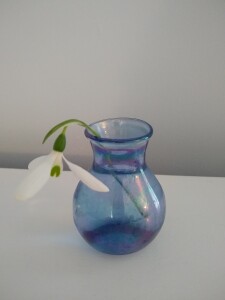 There is an old Christian hymn that starts, “Lo, how a rose ere blooming, forth from a tender stem.” The lyrics continue, describing a rose that blooms “amid the cold of winter.”
There is an old Christian hymn that starts, “Lo, how a rose ere blooming, forth from a tender stem.” The lyrics continue, describing a rose that blooms “amid the cold of winter.”
Despite the fact that a winter-blooming rose is a seasonal impossibility in this climate, I persist in looking for one. In fact, that search is one of my regular rituals in December. On a particular day, usually close to the winter solstice, I take a walk around the garden and look for signs of life. My first stop is always the lower back garden, where a Christmas rose, or Helleborus niger, flourishes in a raised bed. “Christmas rose” is something of a misnomer—at least in my part of the world. Hellebores are not true roses, but are more closely related to buttercups, with white flowers that look a little like large buttercups, or, possibly, species roses. Around here they do not bloom at Christmas, except in extremely mild years.
Still, when I take my first look in December, I check for signs of nascent Christmas roses. The leaves are evergreen, so they do not give up their secrets at first glance. Today I looked at the hellebore from a distance of six feet and saw nothing, but when I got up close and lifted one of the big, palmate leaves, I saw plump, tightly furled white buds just emerging from the cold ground. By my calculations, we won’t have fully opened flowers for another month, but the buds are a very hopeful sign.
On my way back to the house, I checked the bed at the foot of the back steps. Small, brave snowdrops—the earliest-blooming ones in my garden—were wide open, even though the day was cold and snow threatened. The plants, which are probably a variety of the early-blooming species Galanthus reginae-olgae—or “Queen Olga’s snowdrops”—are diminutive—only about six inches tall. Each has three outer petals that flare out like white wings, and three smaller central petals marked with green hearts. If you get up close, these “autumn snowdrops” also have a sweet fragrance. I picked just one for display in the house. Perched in a little vase, it will have minimal decorative impact, but will do wonders for my mental health. The snowdrop doesn’t have much in common with the holly and other greens decking the halls, but it inspires outsized amounts of joy on the darkest days of the year.
If a particularly alluring plant takes your fancy during the growing season, you can either go to the local garden center and buy one, or order from an online vendor. In December the story is different. If you have decided that you must have a Christmas rose, there is not much you can do right now. However, salvation is on the way. The first spring garden catalogs will be hitting mailboxes in the next few weeks and many will list Helleborus niger among the plants for sale Some of those catalogs will also offer price breaks for early orders, so you can at least plan for next December’s flowers.
Snowdrops are a bit different. Many experts think they are most likely to thrive if they are sold “in the green”—in spring after the blooms have faded, but while the foliage is still visible. If you have a friend who grows snowdrops, ask for a division from an established clump. If you don’t have any snowdrop-loving acquaintances, you will have to start with bulbs, which can sometimes be obtained from garden centers. The number of available varieties is likely to be limited to the most common, Galanthus nivalis, plus one or two others. For maximum availability and variety, it’s best to check specialty catalogs for listings. Most will sell you bulbs, which you can plant in the fall. Check bloom times and order the earliest-blooming varieties.
Helleborus niger is supposedly a bit harder to cultivate than its more common relative, Helleborus x orientalis, commonly known as “Lenten rose”. I have not found that to be the case. Christmas roses have the same ground-covering quality as other hellebores and prefer partial shade. Maintenance is minimal, thought he plants look better if you remove the ratty, year-old leaves in spring, allowing the new growth to shine.
Snowdrops take no maintenance at all beyond avoiding digging them up by accident. They are “spring ephemerals”, which means that the foliage hangs around for a few weeks after bloom time, and then disappears until the following late winter or early spring. If you are like me and tend to be forgetful about where you planted your ephemerals, mark the spots, or take pictures of the clumps while the above-ground growth is still visible.
Getting out in the garden in December is good for your spirits. Finding flowers before Christmas is even better. For a good selection of galanthus, including Galanthus olgae-reginae, go to Edelweiss Perennials, 29800 S Barlow Rd., Canby, OR 97013; www.edelweissperennials.com. Christmas rose and other hellebore species and varieties are widely available from garden centers and online vendors that specialize in perennial plants.
